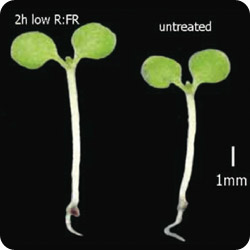Plants use the quantity of blue light to determine how far to open their stomas. The more blue light, the wider they open their stomas, so accelerating their metabolism. High levels of blue light will therefore promote increased metabolism, and by extension accelerate plant growth and development.
Blue light is also responsible for directing leaves and growth points toward the light. Blue light also avoids the multiplication of leaves around the fruits and fertilised plants give more seeds (if applicable to the crop – more female seeds). A shortage of blue light in the spectrum will quickly cause you to lose 20% of your harvest. The optimum red-blue light ratio is 5:1.
Effect of green light and the other colours on plant growth
Plants are hardly sensitive to green light. As far as we know, they lack receptors for this colour. This is probably the case because in practice plants do not absorb this colour. Plants grown exclusively in green light will be exceedingly weak and rarely grow old.
The clear inference is that plants only sense those colours for which they have specific receptors. Plants are therefore not blind but, to a degree, are colour blind when it comes to other colours. Plants react to orange and yellow light more or less as if it were red and to indigo and violet light as if it were blue.
Effect of ‘Invisible’ light on plant growth

The plant on the left is taller because it received
less red light in relation to far-red light. The plant
on the right was exposed to the usual red/far-red
light relationship.
Source: http://www.le.ac.uk
Although plants are a trifle colour blind, they can sense colours that are entirely invisible to us. For example, plants can perceive far-red light. Plants often exploit the red/ far-red relationship. A seed uses this relationship to determine germination. Plants also use that relationship to determine the number of other plants in the immediate vicinity.
Because plants absorb large amounts of red light whilst reflecting far-red light, there will be less red light in a plant’s immediate vicinity if other plants are in the area too. Seeds will hold off germinating and the plants that are already in place will grow faster in order to emerge above the other plants, so acquiring sufficient light for their photosynthesis.
The fact that far-red light has precisely the contrary effect to that of red light makes it unsuitable as a light for growing. The traditional light bulb is a rich source of far-red light.
Ultra violet light (UV) also influences plants. As with blue light, plants perceive this colour using the cryptochrome photoreceptor. It is unclear whether other photoreceptors can perceive UV light.
If the quantity of UV light is increased, the concentration of a purplish substance called anthocyan goes up. Anthocyans protect plants against UV radiation, but also against micro-organisms trying to get in. Anthocyan build-up can often be seen where there are flaws, such as a lack of oxygen. UV light doesn’t only damage the plant’s DNA and membranes, but immediately disrupts the process of photosynthesis. Therefore an excess of UV light is unhealthy for plants.

Left and right: far-red light is reflected by plants and can thus be used to determine the
presence of other plants in the immediate vicinity. Plants can perceive far-red light.
Composition of light
As we have seen, light is not just essential for plants when it comes to supplying energy for photosynthesis. By revealing just a small part of the story we have seen how plants use colours to regulate many of their processes. Plants are capable of perceiving those colours that matter to them. Those colours give the plant an indication of its general environment and thus its chances of survival and reproduction.
If your plants are to develop, grow and flower well, the composition of the light is at least as important as its quantity. Do not forget that a plant perceives the composition of both direct and indirect light. Indirect light here refers to the light that is reflected onto a plant by other objects such as walls or other plants.

